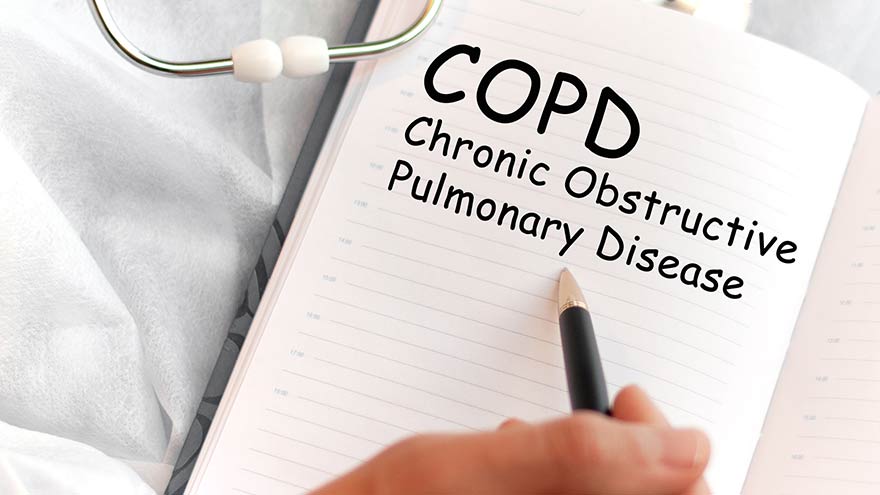Search
-
COPD Explained: Protecting Your Lungs and Managing Symptoms
COPD (chronic obstructive pulmonary disease) is a progressive lung condition often mistaken for typical aging signs, like shortness of breath and coughing. While smoking and pollution can contribute to its development, lifestyle changes and medications can help manage its progression. Diagnosis typically involves lung function tests, chest X-rays, or CT scans, with treatments available through a pulmonologist or primary care provider. Renown’s Pulmonary Rehabilitation Program offers insights into living with COPD. What is COPD? According to the COPD Foundation, it is an umbrella term used to describe progressive lung diseases including: Emphysema: Damage to the small air sacs in the lungs (alveoli). Chronic Bronchitis: Irritation and swelling of bronchial tubes, causing shortness of breath and coughing for long periods of time. Asthma (non-reversible): When asthma medications cannot reduce swelling in the airways. COPD Risk Factors Smoking is the most significant COPD risk factor, and the American Lung Association (ALA) says it accounts for nearly 90 percent of cases. If you are a smoker, it is essential to seek help and quit. Other COPD risk factors include: Air pollution Genetics Second-hand smoke Chemical, fumes or dust in the workplace How Can You Protect Yourself? Stop smoking Renown Health provides support offering 4-week Smoking Cessation Virtual Classes, free of charge! Sign up today. Use natural cleaning products Many household chemicals, especially those containing bleach, can irritate the lungs – a condition called, chemical pneumonitis. Stay away from all types of smoke This includes smoke from fireplaces. Likewise, plan to stay indoors when it is smoky outside, or air quality is poor. Get active Of course, it’s never too late to start an exercise program. When exercising your heart pumps, circulating your blood and sending oxygen to every part of your body. Notably it strengthens your lungs, making it easier to breath. Talk to your doctor to see if you are healthy enough to begin exercising. Eat a healthy diet Surprisingly what you eat can affect your breathing. The American Lung Association encourages those with COPD to watch their sodium intake, eat smaller, more frequent meals (instead of three large ones), limit high fat foods and drink plenty of water. Avoid scented products Perfumes, aerosol sprays and plug-in air fresheners can trigger flare-ups. Get a flu shot Did you know chronic lung conditions, as well as, heart disease, cancer and diabetes, can be made even worse by the flu? Now is the time to get your flu shot for the season if you haven’t already. Renown’s Pulmonary Rehab staff is certified through the American Association for Cardiovascular and Pulmonary Rehabilitation (AACVPR). Recently, Renown Regional Medical Center successfully completed a disease specific COPD certification survey by The Joint Commission. For two accreditation cycles in a row, the COPD Program has had zero findings during the rigorous survey.
Read More About COPD Explained: Protecting Your Lungs and Managing Symptoms
-
Celebrating World Lung Day in Northern Nevada
In the United States, electronic cigarettes are the most popular form of tobacco product used among high school students. Approximately 21% of Washoe County area high schoolers report current use of e-cigarettes, higher than the national average of 14% reported in the most recent national data. While often viewed as a safer alternative to traditional cigarette use, e-cigarette use, commonly referred to as vaping, exposes users to nicotine and harmful chemicals that stunt brain development, results in lung damage and harms overall health. In partnership with Reno area school principals and nurses, the Renown Health – UNR Med Clinical Research Office was able to provide this year’s World Lung Day Anti-Vaping Program to Galena High School, Robert McQueen High School and Sage Ridge School, reaching hundreds of high school students.
Read More About Celebrating World Lung Day in Northern Nevada
-
Living with COPD? How to Maximize Your Summer Experience
June offers an official welcome to summer and the height of outdoor activities in northern Nevada such as hiking, camping, days spent at the lake and embracing long days and warm evenings with friends and family. Enjoying all that the summer season has to offer may not be as easy for those living with chronic obstructive pulmonary disease, or COPD, which effects more than 15 million Americans. What is COPD? COPD is a group of lung diseases including emphysema and chronic bronchitis that result in airflow blockages from the lungs. People may experience frequent coughing and shortness of breath among other symptoms. COPD typically impacts adults ages 65 and older and is becoming increasingly more common among women. Although smoking plays a key role in the development of COPD, air pollution and indoor air quality, and respiratory infection also contribute to disease development. While there is no cure for COPD, limiting progression of disease and managing symptoms can be achieved through lifestyle changes, therapy, and medications. Tips for Living with COPD This Summer, and Always Stay Hydrated: Staying hydrated is extremely important for people with COPD, especially during the summer. Not drinking enough water can make breathing more difficult because it increases respiratory symptoms. Make sure to always keep a water bottle with you and aim to drink 8-10 glasses of water daily. Be Mindful of Temperature: COPD symptoms can be exacerbated by hot weather. It is best to participate in outdoor activities during the cooler times of day, like the morning or evening. Check Air Quality Before You Go: Before engaging in outdoor activities, be sure to check the air quality index and plan your activities accordingly. Pace Yourself: Exercising can be difficult for people who have COPD. To make the most of your summer, try not to push yourself too hard and take breaks when you need them. If you start to feel out of breath or tired, take a break in a cool, shaded area until you feel better. Take Matters Into Your Own Hands To address the needs of community members living with COPD, the Renown Health Research Office has teamed up with Pulmonary Medicine to provide patients who are former or current smokers and have a history of frequent exacerbations with an option to participate in the ARNASA study. "COPD exacerbations have a huge negative impact on patient’s lung function” states Dr. Farah Madhani-Lovely, Chief of Pulmonary Medicine at Renown Health and Assistant Dean of Clinical Research at the University of Nevada, Reno School of Medicine. “We have had inhalers and prednisone for decades but patients are still having exacerbations. Now we have a new pathway we think will prevent exacerbations which is what this clinical trial is designed to prove.” This study will evaluate the efficacy and safety of astegolimab compared with placebo in participants 40-80 years of age with COPD. “This study in particular is so exciting because of the enthusiasm from the sponsor’s end” says Katie Buckley, Lead Clinical Research Coordinator working on pulmonology studies at Renown’s Clinical Research Office. “Often times sites aren’t assigned particularly passionate or engaged personnel who aid in carrying out these studies, but you can tell Roche Genentech’s team truly cares about the success of the study, the safety of their participants, and proving the efficacy of the investigational agent. Working on a study like this takes a village, and when the individuals on all ends share similar mindsets and work towards success as a collective unit instead of as individual moving parts, it’s amazing to see everything we’re able to accomplish.” Renown’s team of expert pulmonologists and researchers are available to join patients with COPD in support of their healthcare journey. If you are interested in learning more about this clinical trial option at Renown Health, talk to your pulmonologist at your next appointment or contact us at 775-982-3646. At Renown Health, our goal is to make it easy for patients to access clinical research as a care opportunity where patients can access a variety of standard care treatment options for their health condition or choose to participate in a clinical trial. For more information about clinical trial opportunities available to you or to ask any questions, contact the Renown Research Office at Renown-CRD@renown.org or 775-982-3646.
Read More About Living with COPD? How to Maximize Your Summer Experience
-
How to Talk to Your Children About Vaping
According to the Centers for Disease Control (CDC), e-cigarette use isn’t just up among adults, but it has also tripled in usage for teens. Dr. Jose Cucalon Calderon, a Pediatrics Physician at Renown Health and an Assistant Professor of Pediatrics at the University of Nevada, Reno School of Medicine, provides helpful insight into e-cigarettes and the dangers it poses to kids and teens. What Are E-Cigarettes? E-cigarettes are electronic nicotine delivery devices. e-cigarettes use liquid nicotine as an alternative to traditional smoked cigarettes. e-cigarettes contain nicotine which is an addictive substance with known toxic side effects that, when released in very high doses, that can have health consequences and causes addiction. Nicotine is described as “toxic,” but the most "toxic" part of e-cigarettes' is everything else within the E-juice. Nicotine mainly keeps people coming back for more. According to the CDC, e-cigarettes are also advertised using the same themes and tactics that have been shown to increase youth use of other tobacco products, including cigarettes. In 2021, approximately 76% of students reported exposure to tobacco product marketing through traditional sources, and approximately 74% of students who used social media had seen e-cigarette–related content. What Does This Mean for the Health My Teen? We know that nicotine can affect brain development in kids and teens, so it is important to educate your teen on the risks of exposure. If you have young children in the home, it is important to be vigilant as well. One teaspoonful of liquid nicotine can be fatal for a young child. How Do I Monitor My Teen for E-Cigarette Use? Monitoring your children can be tricky for parents. E-cigarettes can be harder to detect, unlike traditional cigarettes that were easy to detect by smell and residual odor. E-cigarette use, or “vaping,” is often associated with a dry cough or chronic throat/mouth irritation. Overall, increasing research shows strong links between mental health conditions and posterior combustible tobacco use along with increased risk of marijuana use. Nicotine is addictive, but it does not cause altered mental status like the other drugs of abuse can. All parents are strongly encouraged to talk to their children about the potential dangers of e-cigarettes. What are the health risks of vaping? Vaping devices have been on the market for a relatively short period of time, with evidence-based health effects and complications still being discovered. Vaping effects poses many harmful risks to children and teens. The risks of vaping include: Chest pain Difficulty breathing Dizziness Headaches Impaired response to infection in the airway Inflammatory problems of the airway Nausea Nicotine addiction Seizures Vomiting For more information for both parents and teens about quitting smoking or vaping, you can click here. Parents can also use this tip sheet from the U.S. Surgeon General to talk to their child about vaping. The Substance Abuse and Mental Health Services Administration free national helpline number is 1-800-662-4357 (HELP). It is available 24/7, 365 days a year offering confidential treatment referral and information (in English and Spanish). If you or someone you know is facing a substance (or mental health) problem, please reach out to them.
-
The Risks of Vaping and E cigarettes
In this article reprinted with permission from the Galena Times, Dr. Max J Coppes, Physician-in-Chief, Renown Children’s Hospital, and Nell J. Redfield, Chair of Pediatrics, UNR Med, talk about adolescents vaping, and how an estimated additional 10 million teens are at risk to start using e-cigarettes. What are E-cigarettes? E-cigarettes are battery-operated devices heating a liquid (e-juice) into an aerosol to be inhaled. Breathing in this flavor vapor, which usually contains nicotine, anti-freeze or other cancer-causing chemicals is called ‘vaping.’ There are many forms of these electronic nicotine delivery devices - and they're not always obvious. They not only appear to be cigarettes, cigars, or pipes, but also pass for everyday items, such as flashlights, flash drives or pens. The Effects of Vaping and E-cigarettes Regardless of the nicotine delivery, vaping is addictive and is quickly becoming a public health concern. Nicotine levels in e-cigarettes vary greatly, and they may also contain toxic chemicals. Currently there is a wide range of variability among vaping products. In other words - they deliver different ingredients, hardware, levels of nicotine, and possible toxic chemicals to the user. This makes it challenging to create an overall public health recommendation on their use. Nevertheless, there is no confusion about the harmful effects of the chemicals used in e-cigarettes to the young brain, which develops until age 25. Studies show e-cigarette use serves as an introductory product for teens to go on using ‘regular’ tobacco products. The American Academy of Pediatrics has several recommendations on their use. Such as increasing the minimum age to buy tobacco products, including e-cigarettes, to age 21 nationwide. (Update: nationwide the age as of January 2, 2020 is now 21.) A common misunderstanding with teenagers is the belief e-cigarettes are less harmful than other tobacco products. Moreover, there is a wide range of flavor choices, from mint, mango, crème brûlée to cucumber to attract users. As of September 6, 2019, The Centers for Disease Control and Prevention is reporting over 450 possible cases of lung illness associated with the use of e-cigarette products in 33 states. What Should Parents Know about Vaping? Parents and teachers should know JUUL is a very popular e-cigarette among teenagers, capturing about 68% of the market. JUUL is sleek, small, hides easily, and resembles a flash drive. Surprisingly it charges in an USB port, and can also instantly be mistaken for a real flash drive. One JUUL cartridge contains twice the nicotine found in other e-cigarette cartridges. This roughly equals the amount of nicotine in an entire pack of cigarettes. To repeat, the use of JUUL in young people continues to grow, and this is why parents and teachers need to be aware. Be alert, teach, communicate, and talk to your child about the serious risks of smoking in all forms, whether at home or parties. Tell them how difficult it is to quit and why they should not start. Loving your children is caring; caring for their current and future health and well-being.




